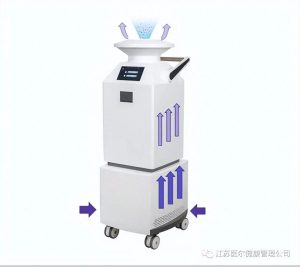Today, we live in an era where we need to pay more attention to air quality and eliminate dangerous bacteria. Hygiene safety has always been a focus of attention, especially during epidemics, and now we are focusing on Mycoplasma pneumoniae.
Mycoplasma pneumoniae: a microorganism between bacteria and viruses
Mycoplasma pneumoniae is a unique pathogen that is neither a bacterium nor a virus. This microorganism is considered to be an organism between bacteria and viruses and is one of the smallest microorganisms that can exist independently in nature. Mycoplasma pneumoniae has no cell wall structure and is therefore naturally resistant to traditional antimicrobial drugs such as penicillin and cephalosporin, making them difficult to treat.
Transmission and infection of Mycoplasma pneumoniae
Mycoplasma pneumoniae infection is a common respiratory infection, especially in children. Children are more susceptible to infection in crowded environments such as kindergartens, primary and secondary schools. Studies have shown that the infection rate of Mycoplasma pneumoniae in children ranges from 0% to 4.25%, and many of the infected people do not have any symptoms. Mycoplasma pneumoniae pneumonia usually accounts for 10% to 40% of community-acquired pneumonia in children and adolescents, especially in children aged 5 years and above, but can also affect children under 5 years old.
Mycoplasma pneumoniae is mainly transmitted through respiratory droplets. When an infected person coughs, sneezes, or has a runny nose, the secretions may carry pathogens. In addition, Mycoplasma pneumoniae may also be transmitted through fecal-oral transmission, air aerosol transmission, and indirect contact, such as contact with items such as clothing or towels with Mycoplasma. However, the risk of infection from these transmission routes is low.
Active medical treatment and Mycoplasma pneumonia infection
In most cases, people infected with Mycoplasma pneumonia have no symptoms or only mild upper respiratory tract infection symptoms such as cough, fever and sore throat. However, a small number of infected people may develop Mycoplasma pneumonia (MPP), the main symptoms of which include fever, cough, headache, runny nose and sore throat. Patients with Mycoplasma pneumonia usually have persistent high fever, and infants and young children may show wheezing. Lung signs may not be obvious in the early stage, but as the disease progresses, weakened breath sounds and dry and wet rales may occur.
Therefore, if a child has symptoms such as fever and persistent cough, parents should be vigilant and actively seek medical treatment. After diagnosis, they should be treated according to the doctor's advice and should not blindly use drugs.
Picture
Prevention of Mycoplasma pneumonia infection
There is currently no specific Mycoplasma pneumonia vaccine, so the best way to prevent infection is through good personal hygiene habits. In the epidemic season, especially in crowded public places, attention should be paid to indoor ventilation to avoid long-term stay.
In addition, frequent hand washing and hand hygiene are also effective ways to prevent infection. Indoor ventilation and hygiene are particularly important in crowded places such as schools and kindergartens. If a child is sick, they should try to rest at home until the symptoms disappear.
Image
Air purification and elimination of dangerous bacteria
In addition to personal hygiene habits, the use of modern air purification equipment can also help reduce the spread of dangerous bacteria. The hydrogen peroxide compound factor disinfector is an excellent device that combines five disinfection factors to provide excellent disinfection effects.
This machine combines passive and active disinfection methods:
Passive disinfection: including ultraviolet irradiation, coarse-effect filtration devices, photocatalysts, etc., effectively remove microorganisms and pollutants in the air.
Active disinfection: Ozone gas and hydrogen peroxide liquid are used to actively generate disinfection factors and disperse the disinfectant into the air in the form of fine atomization. At the same time, the built-in UV chamber of the equipment provides an additional disinfection layer to ensure comprehensive and efficient disinfection.

Hydrogen Peroxide Space Disinfection Machine
The Hydrogen Peroxide Compound Disinfector uses compound disinfectant technology and is designed to provide superior disinfection results. It not only eliminates dangerous bacteria, but also effectively purifies the air, providing safer air quality for your premises.
With the Hydrogen Peroxide Compound Disinfector, you can further enhance hygiene safety and ensure maximum protection of the hygienic environment of your premises.
In this era of health and safety, we need to take all necessary measures to eliminate dangerous bacteria, especially in today's epidemic. Mycoplasma pneumoniae is a common source of respiratory infection, and we need to take measures to prevent infection, but also rely on modern technology, such as the Hydrogen Peroxide Compound Disinfector, to improve our hygiene and safety standards.